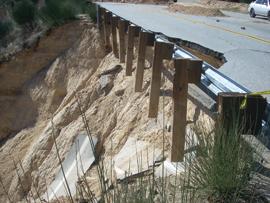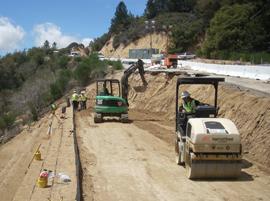Revegetation Innovation (Erosion Control)
By Don Talend
State Route 330 is a vital link for commerce, commuters, and tourists to and from the southern California mountain community. Three sections of the route were severely damaged by a storm late December 2010, and storm drains that were built in the 1940s failed. The result was slope failure and eroded roadway discovered by a routine California Department of Transportation (Caltrans) storm maintenance activity. Improvements included revegetation to stabilize the soil.
The projects detailed in this article are examples of revegetating landscapes that are subject to significant soil erosion using carefully selected seed and, in many cases, soil amendments. The oldest “natural” type of best management practice (BMP) on Earth is becoming an increasingly highly engineered solution to problems created by, or affecting, human activity. Erosion control contractors and materials suppliers can’t afford not to refine methods and materials as budgets and environmental regulations continually tighten.
It was initially believed that SR 330 would take up to two years to repair. Caltrans officials acted quickly by releasing three contracts. Contracts for work on the two lower sections were awarded to Skanska USA Civil West California District Inc., and the contract for the upper section was awarded to SEMA Construction Inc. The initial cleanup work was performed by Skanska to provide clear access for construction crews, Caltrans, emergency services, and the US Forest Service (USFS).


Pacific Restoration Group Inc. (PRG) was contacted by Skanska and SEMA and asked if PRG would join the team as one of the subcontractors to provide habitat restoration and erosion control. PRG works primarily in southern California, specializing in public works projects, according to John Richards, president. About 70% of the company’s sales come from highway, landscaping, and revegetation projects, and 30% are strictly erosion control—mainly hydroseeding, Richards says. The SR 330 work would be a typical project for PRG, at least in the sense that it was publicly financed. The Federal Emergency Management Agency paid 75% of the cost of the repairs, with the state, local counties, and local communities covering the remainder of the total cost.
The combined projects grew to a $1.78 million emergency reconstruction of a 13-mile stretch of SR 330—which had failed in multiple slopes at three major road areas due to heavy runoff from the storms—at elevations of 1,900 to 5,550 feet. The drainage system in the area had been overwhelmed because the existing culverts and pipes were aging and of insufficient size, according to Richards. Skanska and SEMA bid the three emergency contracts to Caltrans with the stipulation of mobilizing within days. PRG’s first call in February 2001 came from the prime contractor, SEMA, on a Friday—a day after the bid was submitted. PRG was to meet with Jeremy Wiest, SEMA’s project manager; Azzan Saad, Caltrans vice president; and USFS staff the following Monday to begin work.
Two weeks later, PRG got a call from Skanska requesting erosion control services as early as April after an 11-foot-diameter drain culvert and 80 feet of fill were completed. Initially, PRG was to provide just hydroseeding but increased its services to include installing coir fiber rolls, streambed hand-seeding, planting locally collected cuttings, installing erosion control coir blankets, temporary application of Profile Products’ Flexterra HP-FGM (High Performance-Flexible Growth Medium) hydraulic mulch, and subsequent hydroseeding.
On the SEMA project, PRG provided much more than erosion control work from February to November 2011 on multiple slopes covering a 7.9-mile stretch of the road. Construction work included temporary BMPs for the stockpiled soil that was removed from the road, excavating the eroded slope several hundred feet down, grading, installing soil-filled gabions, and seeding. SEMA also had PRG assist with the installation of additional culverts and riprap dissipaters at inlet pipes to slow potential runoff and promote native habitat.
Original article written by Don Teland for Erosion Control, see the original article here.

